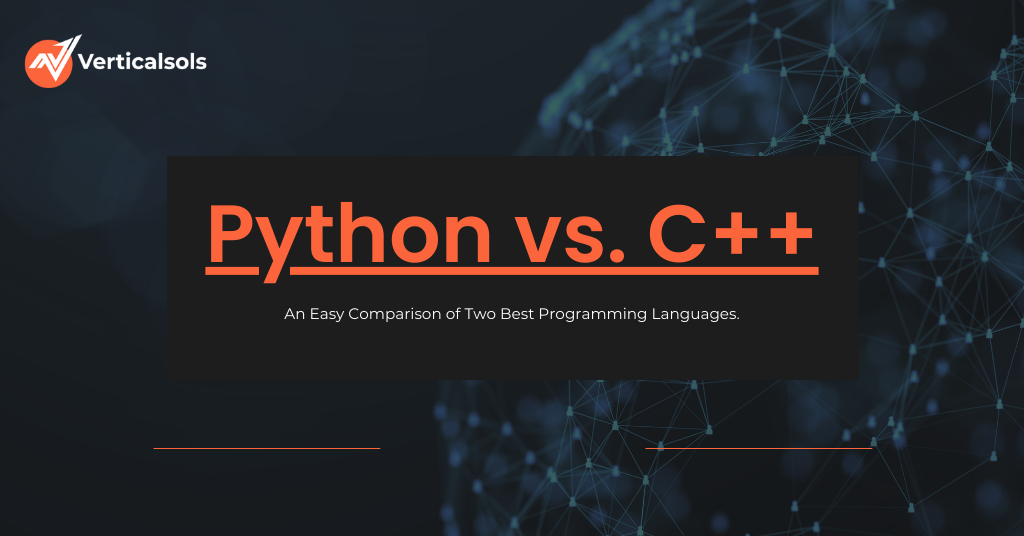Python vs. C++: An Easy Comparison of Two Best Programming Languages.

Verticalsols
16/06/2023
8 minutes

JOIN OVER 7,000+ SUBSCRIBERS
Don't miss out on Insights to boost your business.
Email*

Introduction
Python and C++ are two extensively used programming languages known for their distinct characteristics and extensive applications. Python, with its simplicity and versatility, has gained immense popularity in various domains, while C++ stands out for its performance and low-level control.
This article aims to provide an in-depth comparison of Python and C++ across multiple aspects to help readers make informed decisions based on their specific project requirements and career goals.
I. Syntax and Structure
A. Python
Python boasts a simple and concise syntax that allows developers to write code in fewer lines compared to other languages. The use of indentation for code blocks enhances readability and eliminates the need for explicit braces or semicolons. Furthermore, Python employs dynamic typing, enabling variables to be assigned different types during runtime, providing flexibility and reducing the need for explicit type declarations.
Python's simple and expressive syntax enables developers to focus more on problem-solving rather than dealing with complex language constructs. This readability and ease of use make Python an excellent choice for beginners and professionals alike.
B. C++
C++ syntax resembles that of its predecessor, C, with a few additional features. Code blocks in C++ are defined using curly braces, and semicolons are used to terminate statements. Unlike Python, C++ adheres to static typing, requiring explicit declaration and assignment of variable types. This strong type checking enables better compile-time error detection and can lead to improved performance.
C++'s syntax allows for fine-grained control over memory and resources, making it suitable for applications that demand high performance and efficiency. However, the syntax complexity may pose a steeper learning curve, especially for those new to programming or coming from higher-level languages.
II. Performance and Efficiency
A. Python
Python's interpreted nature impacts its performance compared to compiled languages. The Global Interpreter Lock (GIL) poses challenges for multi-threaded programs as it allows only one thread to execute Python bytecode at a time. This limitation makes it less efficient for CPU-bound and multi-core tasks.
However, Python offers various techniques to enhance its performance. Just-In-Time (JIT) compilation, as exemplified by PyPy, dynamically optimizes the code during runtime, resulting in improved execution speed. Additionally, Python provides seamless integration with performance-critical libraries written in lower-level languages like C or C++, allowing developers to leverage their efficiency when needed.
B. C++
C++ is a compiled language, which offers advantages in terms of performance. The code is translated to machine code before execution, allowing for efficient utilization of system resources. Additionally, C++ enables developers to write low-level and efficient code, providing direct access to memory and hardware.
Unlike Python, C++ does not have a Global Interpreter Lock. This absence allows for better exploitation of multicore processors and improved parallel execution. C++'s performance makes it a top choice for applications that require real-time processing, game development, high-performance computing, and resource-constrained systems.
III. Memory Management
A. Python
Python implements automatic memory management through a garbage collection mechanism. It uses a reference counting mechanism to track object references, and memory is automatically freed when objects are no longer referenced. This approach reduces the need for manual memory management and simplifies the development process.
However, Python's dynamic typing can introduce potential memory overhead due to the need for additional metadata for type handling. The garbage collector periodically pauses the program's execution to reclaim memory, which may lead to brief performance dips in certain scenarios.
B. C++
C++ follows manual memory management, giving developers direct control over memory allocation and deallocation. It utilizes pointers to manage memory, allowing for efficient utilization of system resources. While this manual control offers flexibility and fine-grained memory management, it also introduces the possibility of memory leaks and pointer-related errors if not handled properly.
C++ provides mechanisms like destructors and smart pointers to manage memory automatically to some extent. However, it requires developers to be diligent in managing resources explicitly, especially when dealing with complex data structures and low-level operations.
IV. Use Cases and Application Domains
A. Python
Python excels in various application domains, including scripting, web development, and data analysis. Its ease of use and extensive ecosystem of libraries and frameworks make it a popular choice for automating tasks, building web applications, and performing data manipulation and analysis. Python's rich set of libraries, such as Django and Flask for web development, NumPy and Pandas for scientific computing, and TensorFlow and PyTorch for machine learning and artificial intelligence, contribute to its growing prominence in these fields.
B. C++
C++ is well-suited for systems programming, where direct control over hardware and memory is crucial. It finds extensive usage in operating systems, embedded systems, device drivers, and high-performance computing. Additionally, C++ is widely employed in game development, thanks to its performance and the availability of robust game development frameworks like Unreal Engine and Unity. C++ also offers powerful libraries for graphics rendering, such as OpenGL and DirectX, making it a go-to choice for graphical applications.
V. Community and Ecosystem
A. Python
Python boasts a large and active community of developers who contribute to its growth and development. The Python community is known for its inclusivity, collaboration, and supportiveness. Extensive documentation, online resources, and tutorials are readily available, making it easier for developers to learn and seek help when needed. Notable companies and organizations, including Google, Instagram, Netflix, and NASA, rely on Python for their projects, showcasing the language's widespread adoption and community support.
B. C++
C++ also has a dedicated community of developers who actively contribute to the language's ecosystem. C++ standards are regularly updated, ensuring compatibility and introducing new features and improvements. The availability of various compilers, such as GCC and Clang, along with integrated development environments like Visual Studio and Eclipse, provides developers with reliable tools for C++ development. C++ finds its prevalence in industries such as finance, gaming, telecommunications, and embedded systems, where its performance and low-level control are highly valued.
VI. Learning Curve and Accessibility
A. Python
Python has gained a reputation as a beginner-friendly language. Its clean and readable syntax, along with the availability of interactive shells like IPython, enables newcomers to start writing code quickly and see immediate results. Python's widespread adoption in educational settings, such as schools and universities, and its inclusion in online learning platforms make it easily accessible to individuals interested in programming.
B. C++
C++ is often perceived as a more complex language due to its low-level nature and explicit memory management. Understanding concepts like pointers, memory allocation, and deallocation requires additional effort and attention to detail. However, numerous resources, including textbooks, online tutorials, and forums, cater to beginners seeking to learn C++ from scratch. With persistence and practice, developers can grasp the intricacies of C++ and leverage its power for performance-critical applications.
VII. Conclusion
After conducting a comprehensive comparison of Python and C++, it is evident that both programming languages have their unique strengths and areas of application. Python, with its simple, concise syntax, dynamic typing, extensive ecosystem of frameworks, libraries, excels in scripting, web development, and data analysis. It has gained significant popularity in fields such as machine learning and artificial intelligence, making it a versatile and powerful language for various domains.
On the other hand, C++ stands out with its compiled nature, performance advantages,ability to write low-level and efficient code. It is widely used in systems programming, performance-critical applications, game development, and embedded systems. With powerful libraries for graphics and hardware interaction, C++ provides a solid foundation for developing high-performance applications.
At Verticalsols, we recognize the importance of both Python and C++ in the software development landscape. We understand that different projects and industries may require different programming languages based on their specific needs and objectives. That's why we have dedicated teams of experts proficient in both Python and C++, ready to tackle any project that comes our way.
By offering facilities and expertise in both Python and C++, we ensure that our clients have access to the best of both worlds. Whether you require a dynamic web application, advanced data analysis solution, or complex system-level software, our skilled developers can deliver tailored solutions to meet your requirements.
Furthermore, our commitment to continuous learning and staying up-to-date with the latest advancements in both Python and C++ allows us to provide cutting-edge solutions plus ensure optimal performance for our clients' projects.
It is worth noting that the choice between Python and C++ ultimately depends on your specific project requirements, existing infrastructure, performance considerations, and personal preferences. We encourage you to consult with our team of experts who can guide you in selecting the most suitable language based on your project's needs and goals.
Regardless of whether you choose Python or C++, partnering with Verticalsols guarantees access to a reliable and experienced team, a commitment to delivering high-quality solutions, and a customer-centric approach to software development.
In conclusion, by leveraging the strengths of both Python and C++, Verticalsols is well-equipped to handle a wide range of projects and provide clients with the most suitable and efficient solutions. Take advantage of our expertise in both languages and let us help you unlock the full potential of Python and C++ in your software development endeavors. Contact Verticalsols today and embark on a successful journey to transform your ideas into reality.
Table of Contents


Verticalsols
In this fast-paced digital landscape, I am dedicated to sharing my knowledge and insights with fellow marketers and entrepreneurs. Whether it's through blog posts, webinars, or consulting, I am committed to helping businesses navigate the digital maze and thrive in the digital age.
Related Posts
SOFTWARE DEVELOPMENT
HIRE DEVELOPERS
ABOUT US
- Verticalsols.com
- Address : 34 N Franklin Ave Ste 687#1936 Pinedale, WY 82941
Email :
info@verticalsols.comPhone :
+1 786 224 2151Find Us :
© 2022-2025
Verticalsols LLC